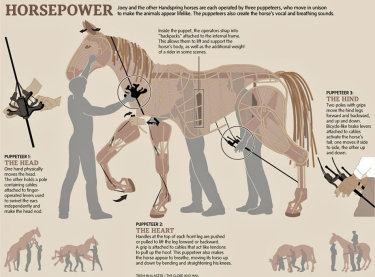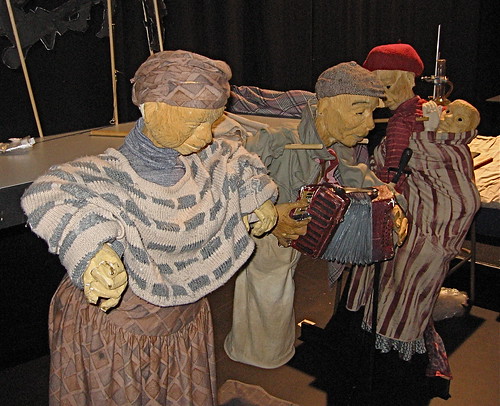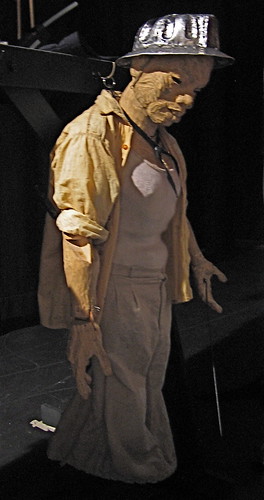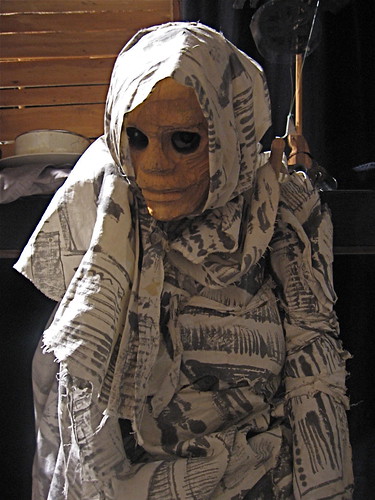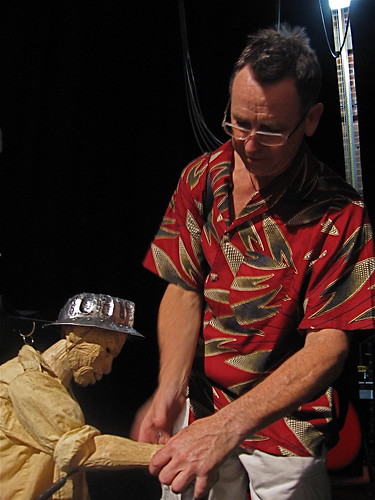My heart did a little flip when I first saw the jellyfish puppet and the large hand and head in this trailer for the Bristol Old Vic/Handspring Puppet Company’s production of A Midsummer Night’s Dream. I love Handspring’s puppets! In the following BBC video you can see some more of the puppets in greater detail if you can put up with the corny interviewer, while some reactions to the play are being storified here. The production is currently on until 4 May, and will also be at the Spoleto Festival USA starting 23 May.
handspring puppet company
War Horse
After hearing Adrian Kohler talking about Handspring Puppet Company‘s War Horse at UNIMA 2008 in Perth, I made a special point of seeing it in London later that year when I was travelling. It was remarkable and wonderful.
Since then War Horse has been much celebrated, and has played to increasing audiences, moving from the National Theatre to the West End, and then to Broadway. Most recently it has been staged in Toronto, and, excitingly, it will be in Melbourne’s Arts Centre in December this year.
I think the TED talk above is the best demonstration of the puppets I’ve seen outside the theatre. Despite their impressionistic construction with movement, breath and emotional gestures they become breathtakingly alive. (Eric Hart linked to this great infographic by Trish McAlaster on how the puppets work.)
The horse puppets get most of the interest, which is natural, but there’s also a lovely puppet goose, and an enormous tank that comes on stage, rolling up over a barricade, and rearing over the audience. I really don’t know how they did that! And I also enjoyed the music and loved the minimalist set, essentially a suggested torn piece of paper above the back of the stage, on which simple animations were projected from time to time.
The attitude towards war in the play is unusual, slipping past taking sides, who is in the right or wrong and strategy, and emphasising rather how the horses’ fates are completely subject to the capricious needs and circumstances of humans.
By now War Horse has been made into the inevitable Spielberg movie, which I somehow don’t feel any particular need to see. (For fun take a look at Lisa Hanawalt’s illustrated review). I’m inclined to think that I would agree with Emily Landau’s article Why war Horse’s puppets win by flaunting their artificiality. Apparently an animatronic horse was used for a few seconds for humane reasons in one scene in the movie. I caught a glimpse of this on YouTube a few weeks ago but the video has since been withdrawn.
Lastly, I love the illustration of the Handspring puppets by Byron Eggenschwiler accompanying Landau’s article.
Handspring’s giraffe
The amazing Handspring Puppet Company‘s giraffe at Design Indaba 2010 in Cape Town recently.
Handspring’s Woyzeck on the Highveld
On the last day of Unima 2008 Gary introduced me to his friends Adrian Kohler and Basil Jones, who co-founded and continue to run Handspring Puppet Company, and I was lucky enough to go backstage to see the puppets from Woyzeck on the Highveld. Thank you all!
The play itself had been a festival highlight for me. First staged 16 years ago, it tells the story of Woyzeck, a man of sensibility and principle, who is brought down by jealousy; but his struggle is informed in every way by the hardships of the migrant labour system under apartheid in the South Africa of the 1950’s.
Two aspects of the show intrigued me in particular.
One was the power of director William Kentridge’s back-projected animations which formed part of the backdrop to the set. They provided not only physical settings to the action and shadow puppets, but at times gave excruciating visual metaphors for what characters were thinking and feeling. For instance, in one scene, Woyzeck is worrying about setting his master’s table. He is doing fine in reality, but in contrast, as he gets increasingly anxious about doing it perfectly, the animation shows great smudges and spills amassing into a chaos that ends in, among other things, a plane crashing and burning.
The other was, of course, the puppets. They are bunraku-style puppets, with beautifully expressive carved (and hollowed out) wooden heads and hands. Adrian is the master puppet maker and designer. He explained how after touring Woyzeck extensively for some years, the company saw selling the puppets as the only way to move on to doing new work. Their latest production, Warhorse, would have been too big to tour, and fortunately, to their surprise, the Munich City Museum was happy to lend the puppets back for the gig at Unima 2008.
Margaret (?), Andries, with the accordion, and Maria with her baby:
The Miner:
The mysterious newspaper death-like character:
Adrian Kohler with the Miner, explaining how the implements in his hand can be changed:
The rhino, showing the rods and mechs on the operator’s side. There is a universal joint in it’s sternum. The red bulb is it’s bladder! (not to be confused with the 2 red chairs in the background).
Here is a video of the rhino in action. You can hear Gary and Adrian chatting.
I loved the rhino most, because it has so much character, and moves in such a life-like way, while being impressionistic in style. I’m very interested in this. Kohler has developed the style much further, too, since building the rhino, as you can see if you look at the horses in Warhorse. Warhorse is the first production where Handspring has moved away from performing their own work, and Adrian commented there were advantages in being solely a maker at times, rather than being a maker/puppeteer.
Incidentally, Handspring is hoping to bring out a DVD of Woyzeck, including the animations, and there is to be a new season of Warhorse in London later in 2008. There’s just a chance I might around to catch it!
Articles I enjoyed reading about Handspring:
Robotic, puppet and tape giraffes!
Andrew at PuppetVision (now here) kindly told me about Make’s report on this huge robotic Electric Giraffe, aka Rave Raffe, a walking vehicle built by Lindsay Lawlor. It’s design follows the mechanism of a toy Tamiya giraffe:
The front and back legs opposite each other step ahead at the same time, propelled by an electric motor. When those legs land, hydraulic brakes lock the wheeled feet, and the other two legs take a step. Canting from side to side, Raffe lumbers ahead at about a mile an hour. A propane engine runs only to recharge the batteries, so the beast is quiet and efficient. When Lawlor let Raffe shuffle off alone in the desert, it walked for eight hours.
— Popular Science
You can follow the building process through to it’s completion in time for Burning Man 2005, when it fulfilled Lawlor’s original purpose, to see Burning Man from a height. The giraffe has done various gigs since then, most recently appearing at Maker Faire. (Still going 2014) Plans are now to add ‘computer-controlled flashing giraffe spots, an electroluminescent circulatory system and a gas grill’. :-)
Some other giraffes of note:
- In 2000, Royal de Luxe (who recently put on The Sultan’s Elephant street theatre spectacle in London) had a similar spectacle, The Hunters of the Giraffes, with a huge puppet giant boy, a mother giraffe and her baby. Scroll down this page for details.
- Handspring Puppet Company‘s Tall Horse has a 5 metre giraffe manipulated by 2 puppeteer on stilts. It tells the story of Zarafa, the giraffe who was taken to France in 1827.
- France’s Compagnie Off‘s Les Girafes, Urban Operetta. PuppetVision has accounts and pictures here, here and in London.
- Mark Jenkins tape sculpture giraffe.
